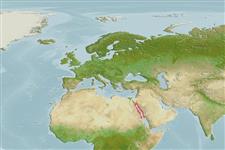Common names from other countries
>
Blenniiformes (Blennies) >
Blenniidae (Combtooth blennies) > Salariinae
Etymology: Ecsenius: Greek, exenios, -os, -on = uncontrolled, immoderate.
Environment: milieu / climate zone / depth range / distribution range
Ecologia
marino associati a barriera corallina; distribuzione batimetrica 10 - 37 m (Ref. 5296). Tropical
Western Indian Ocean: Red Sea and Gulf of Aqaba; south to Djetta, Saudi Arabia and Towartit Reef, Sudan.
Size / Peso / Age
Maturity: Lm ? range ? - ? cm
Max length : 5.5 cm TL maschio/sesso non determinato; (Ref. 9710)
Short description
Chiavi di identificazione | Morfologia | Morfometria
Spine dorsali (totale) : 12 - 13; Raggi dorsali molli (totale) : 16 - 18; Spine anali: 2; Raggi anali molli: 19 - 20; Vertebre: 34 - 37. Dorsal fin XII or XIII (rarely XII),16-18 (rarely 18), deeply notched between spinous and segmented ray sides. Anal fin II,19 or 20. Pectoral fin 13-15 (typically 14). Segmented caudal-fin rays 13. Vertebrae 10 or 11 (rarely 10) + 23-26 (typically 24 or 25) = 34-37 (rarely 34). Dentary
incisor teeth which includes anterior canine teeth very similar in appearance with incisors 46-57; posterior dentary canines 0 or 1 (rarely 0) on each side. Lateral line without pairs
of pores, terminating posteriorly at a point between verticals from dorsal-fin spines 8 and 10. With cirrus on posterior rim of anterior nostril; absent on anterior rim.
Adults occur in coral reefs. Secretive (Ref. 9710). Oviparous. Eggs are demersal and adhesive (Ref. 205), and are attached to the substrate via a filamentous, adhesive pad or pedestal (Ref. 94114). Larvae are planktonic, often found in shallow, coastal waters (Ref. 94114).
Life cycle and mating behavior
Maturities | Riproduzione | Spawnings | Egg(s) | Fecundities | Larve
Oviparous, distinct pairing (Ref. 205).
Lieske, E. and R. Myers, 1994. Collins Pocket Guide. Coral reef fishes. Indo-Pacific & Caribbean including the Red Sea. Haper Collins Publishers, 400 p. (Ref. 9710)
IUCN Red List Status (Ref. 130435)
CITES (Ref. 128078)
Not Evaluated
Threat to humans
Harmless
Human uses
Strumenti
Special reports
Download XML
Fonti Internet
Estimates based on models
Preferred temperature (Ref.
115969): 24.5 - 27.4, mean 26.4 (based on 32 cells).
Phylogenetic diversity index (Ref.
82804): PD
50 = 0.5000 [Uniqueness, from 0.5 = low to 2.0 = high].
Bayesian length-weight: a=0.00741 (0.00335 - 0.01640), b=3.02 (2.83 - 3.21), in cm Total Length, based on LWR estimates for this (Sub)family-body shape (Ref.
93245).
Trophic level (Ref.
69278): 2.0 ±0.00 se; based on food items.
Resilienza (Ref.
120179): Alto, tempo minimo di raddoppiamento della popolazione meno di 15 mesi (Preliminary K or Fecundity.).
Fishing Vulnerability (Ref.
59153): Low vulnerability (10 of 100).
